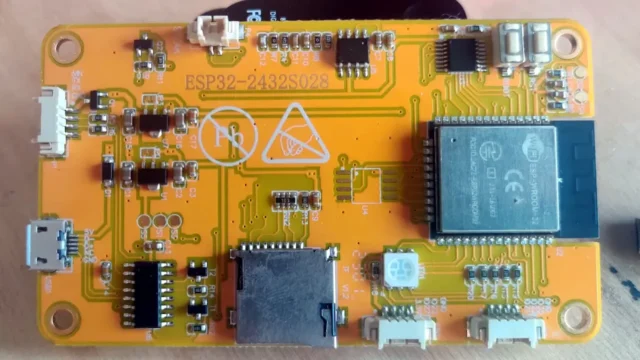TL;DR: You can find the code at GitHub : Wifi Access Point LED Test
I’ve been tinkering with the CYD for a bit now, trying to come up with something cool to use it for. There are a lot of talented coders out there who either wrote or adapted awesome software for the little board. Wanting to contribute, I’ve been racking my brains trying to come up with something to add.
At first I came up with a photo slide show. A quick search showed that there was already a couple of slide shows example out there, and they looked/worked better than what I can come up with at the moment. I may circle back to it, when my coding improves, and add things like transitions, etc.
My next idea was a sort of wireless flash drive. When powered up, the CYD would create a Wifi Access Point, that you could connect to with your phone or computer. The main display would show the Wifi AP name, the password to access the Wifi AP (if one was specified), and the IP address to connect to the web server that would be the main interface for the whole flash drive. The web server would allow you to list, upload, download, and delete files on the sd card attached to the CYD. I searched around, and hadn’t seen anything like it already done. This was my new project.
I soon realized I was in waaaaay over my head.
Microsoft Copilot started me off in the right direction, kinda. It wrote some code directly for ESP32-2431S028, but it used a strange library, that was a fork of another library, that was a fork of another, etc, to the fourth generation (I’m pretty sure this the same thing as Microsoft’s ‘.DLL Hell’ back in the day). Plus the generated code was missing a crucial bit in the middle of several functions. I figured that out after exploring the library’s examples, but it still took a couple of hours. The sketch would compile, upload, and run. I could connect, and bring up the webpage, and interact with it, but it was sooo sloooow.
It would take minutes for the server to respond to requests, if it ever did. I tried this with several libraries, more examples, more Copilot. Several hours, and much frustration, later, I gave up working with custom libraries, started working with the base ESP32 libraries. I needed to simplify, and actually work my way up to the app I wanted.
I found an example in the base Wifi library. WiFiAccessPoint.ino by Elochukwu Ifediora (fedy0). It created a basic Wifi AP, and served up a webpage with 2 links. One link would turn an LED on, and the other would turn the LED off. Using that as a base, I adapted the code so that Wifi AP was customizable, The information to access the Wifi AP was displayed on the CYD’s screen, and would serve up a page with 3 links. Each link would toggle the red, green, or blue of the CYD’s built-in LED. Proof of concept in this video (Excuse the second ‘IP Address’ on the display, it should have said ‘Password’, this was corrected in the code, but the video had already been shot.)
This was a learning project, and it really helped me get back into the swing of coding. It’s now the base for my Wireless Flash Drive project. You can go to my Github to download the code, or just copy and paste the code from here into a new Arduino sketch, and upload it to your CYD.
/************************************************************************************************************
Wifi Access Point LED Test for ESP32 Cheap Yellow Display
Adapted by Michael Bapst (https://www.einherjar.org)
Creates a customizable Wifi Access Point and serves up a Webpage (Default: 192.168.4.1) with 3 links.
Displays Server access information on the display. Clicking a link will toggle CYD's built in LED Red/Green/Blue colors on/off
This code was a learning project on how to set up a Wifi access point, serve simple html, how to deal with simple client requests,
and working with simple GPIO interface.
WIFI_AP_LED_TEST.ino based on WiFiAccessPoint.ino
Created for arduino-esp32 on 04 July, 2018 by Elochukwu Ifediora (fedy0)
*************************************************************************************************************/
// Make sure to copy the UserSetup.h file libraries\TFT_eSPI as
// per the Github Instructions . The pins are defined in there.
// https://github.com/witnessmenow/ESP32-Cheap-Yellow-Display/blob/main/DisplayConfig/User_Setup.h
#include <WiFi.h>
#include <NetworkClient.h>
#include <WiFiAP.h>
#include <TFT_eSPI.h>
#define LED_GREEN 16 // Set the CYD's LED GPIO pin for Green
#define LED_RED 4 // Set the CYD's LED GPIO pin for Red
#define LED_BLUE 17 // Set the CYD's LED GPIO pin for Blue
// Uncomment the next lines if you want a custom IP Address, otherwise the default is 192.168.4.1
// const IPAddress APIPAddress(10, 10, 10, 1);
// const IPAddress SubNetIP(255, 255, 255, 0);
// Set these to your desired credentials.
const char *ssid = "TestServer";
const char *password = "123456789"; // Set to "" for no password, Open Network
NetworkServer server(80);
TFT_eSPI tft = TFT_eSPI();
void SetLED(int LEDColor, bool On_Off = true) {
//Turns on or off the built in LED color
switch (LEDColor) {
case LED_RED:
if (On_Off == true) {
digitalWrite(LED_RED, LOW);
} else {
digitalWrite(LED_RED, HIGH);
}
break;
case LED_BLUE:
if (On_Off == true) {
digitalWrite(LED_BLUE, LOW);
} else {
digitalWrite(LED_BLUE, HIGH);
}
break;
case LED_GREEN:
if (On_Off == true) {
digitalWrite(LED_GREEN, LOW);
} else {
digitalWrite(LED_GREEN, HIGH);
}
break;
default:
break; //Do Nothing
}
}
void setup() {
// Set up the LED GPIO pins and turn them all off.
// The RGB LED set up is reversed. HIGH = ON, LOW = OFF
pinMode(LED_RED, OUTPUT);
pinMode(LED_GREEN, OUTPUT);
pinMode(LED_BLUE, OUTPUT);
digitalWrite(LED_RED, HIGH);
digitalWrite(LED_BLUE, HIGH);
digitalWrite(LED_GREEN, HIGH);
Serial.begin(115200);
Serial.println();
Serial.println("Initializing screen...");
// Initialize the LCD Screen
tft.init();
tft.setRotation(1); // This is the display in landscape
tft.fillScreen(TFT_BLACK);
Serial.println();
Serial.println("Configuring access point...");
// Setup Wifi Access Point
WiFi.mode(WIFI_AP_STA);
// Uncomment the next line If you set a custom IP Address
// WiFi.softAPConfig(APIPAddress, APIPAddress, SubNetIP);
// You can remove the password parameter if you want the AP to be open.
// a valid password must have more than 7 characters
if (!WiFi.softAP(ssid, password)) {
log_e("Soft AP creation failed.");
while (1);
}
IPAddress myIP = WiFi.softAPIP();
Serial.print("AP IP address: ");
Serial.println(myIP);
server.begin();
Serial.println("Server started");
//Print Title
tft.setTextColor(TFT_RED, TFT_BLACK, true);
tft.drawCentreString("Wireless AP Server LED Test " , 160, 10, 4);
//Print Host Name to screen
tft.setTextColor(TFT_YELLOW, TFT_BLACK, true);
tft.drawString("WIFI AP Name:", 5, 40, 2); // Left Aligned
tft.setTextColor(TFT_WHITE, TFT_BLACK, true);
tft.drawCentreString(ssid, 160, 40, 2);
//Print IP Address to screen
tft.setTextColor(TFT_YELLOW, TFT_BLACK, true);
tft.drawString("IP Address:", 5, 70, 2); // Left Aligned
tft.setTextColor(TFT_WHITE, TFT_BLACK, true);
tft.drawCentreString(WiFi.softAPIP().toString(), 160, 70, 2);
//Print Password to screen
tft.setTextColor(TFT_YELLOW, TFT_BLACK, true);
tft.drawString("Password:", 5, 100, 2); // Left Aligned
tft.setTextColor(TFT_WHITE, TFT_BLACK, true);
if (password == "") {
tft.drawCentreString("<NONE>", 160, 100, 2);
} else {
tft.drawCentreString(password, 160, 100, 2);
}
}
void loop() {
NetworkClient client = server.accept(); // listen for incoming clients
if (client) { // if you get a client,
Serial.println("New Client."); // print a message out the serial port
String currentLine = ""; // make a String to hold incoming data from the client
while (client.connected()) { // loop while the client's connected
if (client.available()) { // if there's bytes to read from the client,
char c = client.read(); // read a byte, then
Serial.write(c); // print it out the serial monitor
if (c == '\n') { // if the byte is a newline character
// if the current line is blank, you got two newline characters in a row.
// that's the end of the client HTTP request, so send a response:
if (currentLine.length() == 0) {
// HTTP headers always start with a response code (e.g. HTTP/1.1 200 OK)
// and a content-type so the client knows what's coming, then a blank line:
client.println("HTTP/1.1 200 OK");
client.println("Content-type:text/html");
client.println();
// the content of the HTTP response follows the header:
client.print("<font size = \"5\">");
client.print("Click <a href=\"/RED\">here</a> to turn TOGGLE the RED LED.<br><br>");
client.print("Click <a href=\"/BLUE\">here</a> to turn TOGGLE the BLUE LED.<br><br>");
client.print("Click <a href=\"/GREEN\">here</a> to turn TOGGLE the GREEN LED.<br><br>");
client.print("</font>");
// The HTTP response ends with another blank line:
client.println();
// break out of the while loop:
break;
} else { // if you got a newline, then clear currentLine:
currentLine = "";
}
} else if (c != '\r') { // if you got anything else but a carriage return character,
currentLine += c; // add it to the end of the currentLine
}
// Check to see if the client request was "GET /RED", "GET /GREEN", or "GET /BLUE"
// and toggle the correct color.
if (currentLine.endsWith("GET /RED")) {
Serial.println("Red Clicked");
if (digitalRead(LED_RED) == HIGH) {
Serial.println("RED on");
SetLED(LED_RED, true);
} else {
Serial.println("RED off");
SetLED(LED_RED, false);
}
}
if (currentLine.endsWith("GET /BLUE")) {
Serial.println("BLUE Clicked");
if (digitalRead(LED_BLUE) == HIGH) {
Serial.println("BLUE on");
SetLED(LED_BLUE, true);
} else {
Serial.println("BLUE off");
SetLED(LED_BLUE, false);
}
}
if (currentLine.endsWith("GET /GREEN")) {
Serial.println("GREEN Clicked");
if (digitalRead(LED_GREEN) == HIGH) {
Serial.println("GREEN on");
SetLED(LED_GREEN, true);
} else {
Serial.println("GREEN off");
SetLED(LED_GREEN, false);
}
}
}
}
// close the connection:
client.stop();
Serial.println("Client Disconnected.");
}
}

